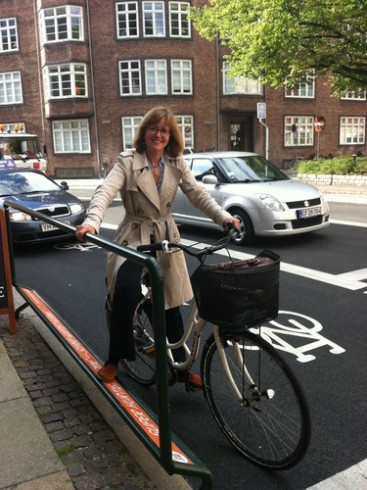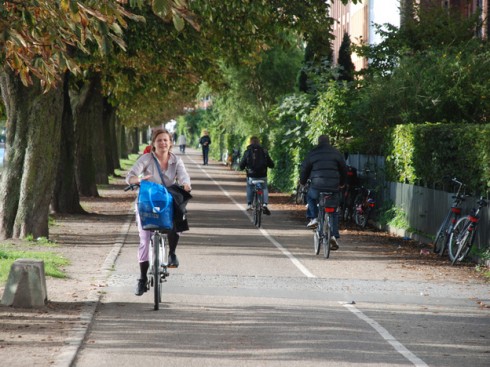A story ran on the program NPR (National Public Radio) Weekend Edition Saturday on September 1, 2012 about “bicycle superhighways” being constructed between Copenhagen and its suburbs. The NPR piece, with comments, is online as text with photos, here:
http://www.npr.org/2012/09/01/160386904/in-bike-friendly-copenhagen-highways-for-cyclists.
Audio is online, linked from the Web page.
As a bicycling advocate, I am looking for useful answers as to what works for bicyclists, based on accurate descriptions. In this NPR report, as in many others, the new bicycle routes between Copenhagen’s suburbs and the city are described as “bicycle superhighways”. But — the article tripped over itself when the reporter described waiting at traffic lights. Superhighways don’t have traffic lights, they have interchanges with grade separations.

NPR reporter Eleanor Beardsley holds a handrail on what is described as a “bicycle superhighway.” in Copenhagen, Denmark.
The caption to this photo on the NPR site reads:
NPR reporter Eleanor Beardsley rides in one of the new bike lanes in Copenhagen. The city is building more than two dozen lanes from the suburbs into the city. They cater to cyclists by including such things as rails and footrests at stoplights.
The photo and caption add even more confusion. This is no bicycle superhighway. Not only is it clear that there must be a stoplight, but the photo shows a lane shared with motor vehicles. Ms. Beardsley evidently doesn’t know the difference between a bike lane and a shared lane.
Another photo with the online article shows a stretch of a separate bikeway in an urban setting:
This is a stock photo, credited:
Slim Allagui/AFP/Getty Images
The caption to this photo on the NPR site reads:
Many Copenhagen residents already travel by bike, and now the city is building high-speed routes designed to encourage commuters even in the outlying suburbs.
This is a wide bikeway, but several features suggest that high speed isn’t the norm here. Two of the three cyclists are pedaling on the arches of their feet. There is a pedestrian standing in the bikeway. Bicycles are parked along its side where the cyclists would have to get off and walk along or across it to reach any useful destination.
On the other hand, a map of the Copenhagen suburb of Albertslund, mentioned as the terminus of the first “bicycle superhighway” constructed, shows a rail corridor which might support a bikeway with few street crossings. In the Google map below, the rail line runs from west to east into Copenhagen.
A close look at the railroad corridor in Google’s Street View shows no bikeway, but on the other hand, the major east-west highway has one-way bicycle (and motor scooter) sidepaths, as shown below:
The Google map and photo probably predate the new installation, though.
A New York Times article,
is somewhat more informative than the NPR story, indicating that the bikeway is really more a bicycle path than a superhighway, and that it has relatively few intersections with roads. So, we’re still trying to find it.
A story from the Danish authorities is even more informative:
The Treehugger blog even has a very small map (and a link to a video which is unfortunately no longer available available in a Huffington Post article:
http://www.treehugger.com/bikes/what-its-ride-denmarks-bicycle-superhighway-video.html
A Danish government site makes it clear that this route and others like it were assembled mostly by stringing together and upgrading existing bicycle routes.
http://www.cykelsuperstier.dk/concept
The most informative set of pictures is here:
http://www.demotix.com/news/1353441/bicycle-superhighways-and-green-bicycle-path-systems-copenhagen#slide-1
[Archived page is available but photos appear not to be.]
I would like to check out these bikeways so I could know more, but based on the stories, I might ask:
- How do these “superhighways” differ from what we call bicycle paths, or shared roadways, here in the USA?
- What is the effect of the traffic lights on travel time?
- Are there intersections where conflicts with cross traffic are not signal-controlled?
- What is the carrying capacity?
- How well is the wide range of level-ground speeds of bicyclists (8 mph to 25 mph) accommodated so the slower ones don’t hold back the faster? (At least, the Copenhagen region is very flat, so speed issues due to terrain aren’t much of an issue.)
All in all, based on what information I can glean from the news reports, the Danish “bicycle superhighway” doesn’t appear to me to be either as direct or as consistent in quality as many American shared-use paths!
This post is a revised and expanded version of comments I posted on the NPR Web site. I do thank NPR for the opportunity to comment, and for the clarification — even if only tangential — about whether the new bike routes are really superhighways .
The other stories provide all too little information. The “superhighway” description, the one I have heard everywhere, is hype, as all too usual with promotion of bicycle facilities, and the Danish Web page shows that the hype in this case originated with the Danish government. This has been a post about that issue, but also about quality of reporting and the lamentable difficulty of obtaining good, useful information about bicycling infrastructure projects..


Pingback: Copenhagen “bicycle superhighways” have traffic lights — but what … | Bicycle News Gator
Yeah, its kind of joke, but to be fair they are not called superhighways in Danish but Super bicycle tracks, and even then most agree that they are not really that super. There is a video of the entire route here if you scroll down a bit:
http://politiken.dk/debat/skrivdebat/ECE1615543/er-koebenhavns-nye-cykelsti-virkelig-super/
The two next ones which will open are another story though, as they mostly have their own right of way, and use viaducts or bridges to cross streets.
Analogous to early freeways, such as the Pasadena Freeway, that look laughable nowadays?
London has a much more extensive network of Cycle Superhighways. They are a joke too. When I first heard them mentioned, I had this utopian image of 20ft wide freeway style bike paths, with underpasses, overpasses and freeway style merges onto surface streets. The reality is a dangerously narrow stripe of blue paint squeezed into the gutter of otherwise unaltered roads.
In other words, business as usual for those who make a business out of traffic engineering, and cyclists get screwed again.
Pingback: Danish story, video and comments on the Albertslund-Copenhagen “bicycle superhighway”. | John S. Allen's Bicycle Blog